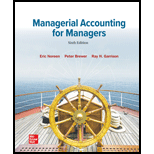
1.
Introduction: The company uses various performance measures to determine whether the performance of the company is in line with the strategies of the company. For this purpose, it uses balanced scorecards consisting of various performance measures which are determined by considering the strategic goals of the company.
To provide: Plausible performance measures for each comment raised in a brainstorming session.
2.
Introduction: If-then hypothesis statements are built to establish the causes and effect relationships between the performance measures in the balanced scorecards. These help in determining whether the performance measures in the balanced scorecards contribute to the strategic goals of the company or not.
To build an if-then hypothesis statement for the strategy.
Want to see the full answer?
Check out a sample textbook solution
Chapter 12 Solutions
Loose Leaf For Managerial Accounting for Managers
- Please explain the solution to this financial accounting problem with accurate principles.arrow_forwardCan you solve this general accounting problem with appropriate steps and explanations?arrow_forwardPlease explain the solution to this financial accounting problem with accurate explanations.arrow_forward
- Please explain the solution to this financial accounting problem with accurate explanations.arrow_forwardComputer the total manufacturing costs and the total cost of work in process.arrow_forwardCan you help me solve this financial accounting question using the correct financial procedures?arrow_forward
 Managerial AccountingAccountingISBN:9781337912020Author:Carl Warren, Ph.d. Cma William B. TaylerPublisher:South-Western College Pub
Managerial AccountingAccountingISBN:9781337912020Author:Carl Warren, Ph.d. Cma William B. TaylerPublisher:South-Western College Pub Financial And Managerial AccountingAccountingISBN:9781337902663Author:WARREN, Carl S.Publisher:Cengage Learning,
Financial And Managerial AccountingAccountingISBN:9781337902663Author:WARREN, Carl S.Publisher:Cengage Learning, Managerial Accounting: The Cornerstone of Busines...AccountingISBN:9781337115773Author:Maryanne M. Mowen, Don R. Hansen, Dan L. HeitgerPublisher:Cengage Learning
Managerial Accounting: The Cornerstone of Busines...AccountingISBN:9781337115773Author:Maryanne M. Mowen, Don R. Hansen, Dan L. HeitgerPublisher:Cengage Learning- Principles of Accounting Volume 2AccountingISBN:9781947172609Author:OpenStaxPublisher:OpenStax College
 Cornerstones of Cost Management (Cornerstones Ser...AccountingISBN:9781305970663Author:Don R. Hansen, Maryanne M. MowenPublisher:Cengage Learning
Cornerstones of Cost Management (Cornerstones Ser...AccountingISBN:9781305970663Author:Don R. Hansen, Maryanne M. MowenPublisher:Cengage Learning




